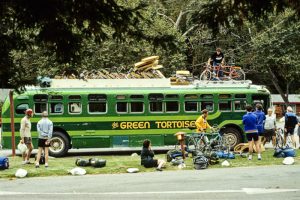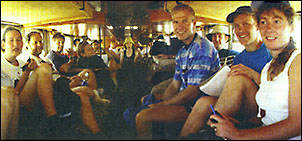Slow, But Steady
 As any veteran of the 60s can report, the “long, strange trip” had very little to do with getting from point A to point B in a straight line. And that’s just the way it is with Green Tortoise, a slightly eccentric bus line that has been taking people on adventure tours for 24 years.
As any veteran of the 60s can report, the “long, strange trip” had very little to do with getting from point A to point B in a straight line. And that’s just the way it is with Green Tortoise, a slightly eccentric bus line that has been taking people on adventure tours for 24 years.
The basics of a Green Tortoise trip are days spent outdoors: hiking, swimming, kayaking, exploring caves, rafting, windsurfing and snorkeling. These are camping tours, which means that travelers’ nights are either on the bus or on the ground, and a number of tours include multi-day river trips or hikes, like the four-day trek included in the Alaskan tour.
“We try to take people to places that are unknown to most conventional motor coach tours,” says Lyle Kent, general manager and son of founder Gardner Kent. “And we’re not afraid to adjust the itinerary if the drivers have discovered something new.” That kind of freewheeling attitude is one of the best-known Tortoise traits, and part of the reason for its small but solid following.
 When the Green Tortoise started in the early 70s, there were several alternative bus lines, like the Gray Rabbit and Gypsy Flyer, offering cross-country trips to members of the counter-culture. They featured custom interior platforms, so passengers could sleep comfortably while the bus was being driven—a popular aspect of today’s Tortoise buses. Gardner joined their ranks with a modified Chevy school bus, which he had most recently driven through Mexico. While the others were making the coast-to-coast run in three days, Gardner decided to do things a little differently. “He took five days, using the extra time to stop at a few parks along the way, have some cookouts and enjoy the trip,” says Kent. “The adventure aspect of it just sort of grew from there.”
When the Green Tortoise started in the early 70s, there were several alternative bus lines, like the Gray Rabbit and Gypsy Flyer, offering cross-country trips to members of the counter-culture. They featured custom interior platforms, so passengers could sleep comfortably while the bus was being driven—a popular aspect of today’s Tortoise buses. Gardner joined their ranks with a modified Chevy school bus, which he had most recently driven through Mexico. While the others were making the coast-to-coast run in three days, Gardner decided to do things a little differently. “He took five days, using the extra time to stop at a few parks along the way, have some cookouts and enjoy the trip,” says Kent. “The adventure aspect of it just sort of grew from there.”
That same cross-country trip, from San Francisco to Boston, now takes Green Tortoise either 10 or 14 days, stopping in state and national parks for hikes, rafting and soaks in hot springs. Fifteen other trips have been added to that first one, from a 24-hour San Francisco-to-Seattle commute, to a month-long Alaskan Expedition (a trip that includes a ferry ride through the Inside Passage and a five-day visit to Denali National Park).
Heading South
Green Tortoise buses also travel through Baja California, mainland Mexico and Central America. One of the most popular trips is the 15-day Costa Rica Loop. “That’s one of our best trips,” says Kent. “We go to two volcanoes, we raft down a river, take a three-day boat trip on the Rio San Juan and end up at Tortugero, a national park on the coast.” Tortugero is a rainforest with a beach on the Caribbean, and one of the most important nesting sites for green sea turtles in the region. Passengers travel through the preserve by boat and on foot, spotting parrots, howler monkeys and crocodiles.
On the other end of the geological spectrum is the Desert Loop, a nine-day tour of the American Southwest, on which passengers hike through canyons, climb the red rocks around Sedona, and take a boat trip up the Colorado River. They soak in hot springs and sleep at an abandoned homestead, a secret spot in the midst of the Sonora Desert that the company is meticulous about preserving intact. Green Tortoise is very sensitive to environmental protection along its routes: Campers set up shelters, but no permanent buildings. Everything packed in is packed out, and the goal is to leave the places visited cleaner than they were before.
The Green Tortoise is not for everyone. Nearly all the meals are vegetarian, cooked by staff and passengers. Rather than being a problem, the cooperative nature of preparing meals brings the passengers closer together, one of the often-mentioned bonuses of Green Tortoise trips.
Wilbert Flinterman of Holland enjoyed his first Green Tortoise tour so much he’s come back to the U.S. for three more. “These are fairly primitive holidays,” he says. “No luxury whatsoever, but I haven’t heard anybody complaining about it. You get to visit such beautiful places, spend all day outside, and it’s so good for making friends.”
There’s no age limit—on an average trip, ages range from 18 to 56, with most passengers in their mid-20s. Many are European students, especially in the summer. Trips cost between $40 and $50 a day, including breakfast, dinner and about half the lunches. Passengers just need to bring their own sleeping bag, appropriate clothing for the destination, and a green sense of adventure.
STEVE WILSON is a freelance writer in Healdsburg, California.

